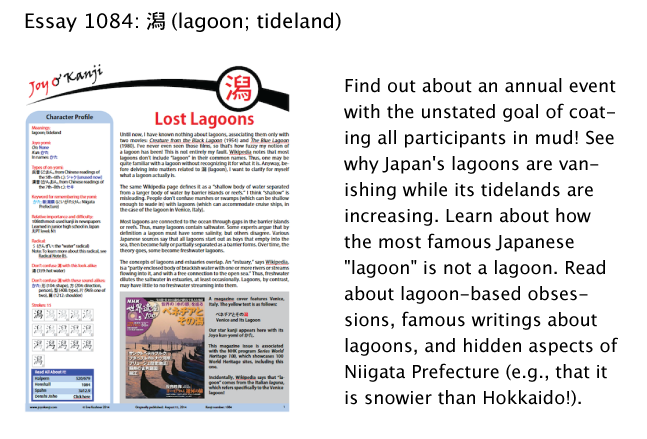Immaterial
Ever since I found out about Robin Williams's suicide, I've had a heavy heart. I keep thinking about him and his incredibly complex mind. That doesn't help much. I keep reading about him and watching videos of him. That doesn't help much. I'm beginning to wonder how I ever lived without having him on the brain all the time.
Playing with kanji has proven to be just about the only way to distract myself and feel the occasional rush of joy. In the hopes that kanji is also your "happy place," let's do a quiz.
On the left you'll find a list of materials. On the right are objects that contain these materials, at least in the form of radicals. Using some materials twice, match the two columns.
| 1. wood | a. altar | |
| 2. dirt | b. money | |
| 3. shell | c. cake | |
| 4. grass | d. paper | |
| 5. metal | e. pillow | |
| 6. thread | f. saké cup | |
| g. picture | ||
| h. bowl |
I'll block the answers with a preview of the new essay on 潟:

Actually, there's a connection of sorts between the quiz and the lagoon essay in that both have to do with considerable change. Over the years, the Japanese have filled in many lagoons (or parts of lagoons), turning them into land for crop production and housing. Some lagoons have also changed shape on their own, separating themselves from the sea. Nothing stays the same....
In the kanji related to the quiz, a radical implies that an object is made of a certain material when circumstances have actually evolved and that's no longer the case. In a sense, the radical has become immaterial. Let's see how.
1. wood, tree (木)
e. 枕 (2115: pillow)
Way back when, according to Kanjigen, Japanese pillows were typically made of wood! Thus, the left side of 枕 means "tree."
f. 杯 (1685: saké cup)
Originally, this character represented a wooden goblet, so the 木 made sense. Now, although it's possible to find a cup in Japan made of lacquered wood, people predominantly associate 杯 with pottery.
2. dirt, earth (土)
a. 壇 (1571: altar)
Initially, says Henshall, 壇 meant “raised earth,” which led to “stage” and “platform." Kanjigen agrees that 壇 originally symbolized an "earthen mound" or "platform with a flat top." Nowadays, a fancy, highly decorated altar made of gleaming, lacquered wood couldn't be farther from the concept of dirt!
3. shell (貝)
b. 貨 (432: money, goods)
Because the ancient Chinese used shells as money, 貝 has come to mean "valuable items" or "assets" when it serves as a radical, says Henshall. Thus, 貝 appears inside many characters associated with money, such as 貨.
4. grass (艹)
c. 菓 (1047: cake, confection)
Henshall says that in this character, "plant" (艹) + "fruit" (果) yields "fruit" again. Well, that was a primary meaning of 菓, one that rarely comes into play nowadays. The primary definition is "confection."
5. metal (金)
h. 鉢 (1705: bowl, pot)
When I think of bowls, my mind goes to pottery and plastic well ahead of metal. Henshall says that this character originally referred to a metal vessel but now can apply to a range of vessels, including the skull, which after all is a vessel for the brain!
6. thread (糸)
d. 紙 (132: paper)
It's no big leap to think of paper as consisting of thread, but the route by which 糸 worked its way into paper is more indirect than I would have guessed. In the beginning, says Henshall, 紙 referred to "smooth silk" and by extension "smooth cloth." Ancient people used cloth as writing material, so 紙 came to mean "writing material" and then "paper."
g. 絵 (89: picture)
This character first represented "embroidered picture," says Henshall. Thus, "thread" was relevant before 絵 came to mean just "picture."
So there you have it. Everything has an explanation, and yet so much remains a mystery. Radicals serve as ghostly reminders of the past. So do my thoughts!
Have a great weekend.

Comments